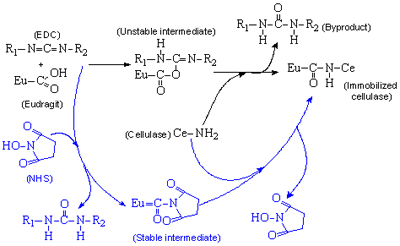- Home >> News >> Research Progress
A Smart Biocatalyst Preparation: Cellulase Immobilization
It has long been very difficult for cellulase to be convalently immobilized on Eudragit L-100 (a copolymer of methacrylic acid and methyl methacrylate). Recently, researchers in GIEC used EDC (1-Ethyl-3-(3-dimethylaminopropyl) carbodiimide) to couple cellulase on Eudragit L-100 in the absence of acetate and added NHS (N-hydroxysuccinimide) to enhance the carbodiimide coupling. EDC is a carboxyl group activator and its oriented coupling should avoid the presence of non-target carboxyl groups’ chemicals such as the common acetate. NHS could help to form a stable intermediate which could enhance the coupling.
Results showed cellulase was successfully covalently immobilized on Eudragit L-100 and more than 80% of activity yield was obtained (noncovalent method could get only 20% of activity yield). Besides, researchers also studied the properties of the immobilized cellulase. Compared to free cellulase, immobilized cellulase exhibited significantly outstanding properties including pH, storage and temperature stability. Moreover, over 50% productivity was retained after 5 cycles for hydrolysis of insoluble cellulosic materials and a continuous reactor (materials feed: 2 kg/h) for using the immobilized cellulase was designed. At present, the reactor is debugging and is highly expected to be scaled up to industrial level. The above works were mainly accomplished by Dr. Yu Zhang, associate professor Jing-Liang Xu and professor Zhen-Hong Yuan.
Cellulase could catalyze cellulose to reducing sugars including glucose, which has large potential value in biorefinery. However, high cost of cellulase production seriously hindered its industrial applications. To address this problem, cellulase immobilization was proposed. Conventional immobilization of cellulase on insoluble or soluble polymers could not simultaneously provide good contact (during the reaction) and simple recovery (after the reaction). Therefore, Eudragit L-100, a soluble-insoluble polymer was used to immobilize cellulase in our study. Via the immobilization, cellulase was converted to a smart biocatalyst that could be used as a homogeneous catalyst during the reaction and recovered by simple solid-liquid separation after the reaction for reuse.
The work has received support from the Knowledge Innovation Program of the Chinese Academy of Sciences (KSCX-YW-11-A3) and National High Technology Research and Development Program of China (863 program, 2007AA05Z406). The related results has been published on Bioresource Technology (2010,101: 3153-3158) and Biocatalysis and Biotransformation (2010,28: 313-319).

Carbodiimide coupling of cellulase on Eudragit L-100 in the absence (upper) and presence (lower) of NHS
